Charger Efest BIO V2
Efest has modified this charger and a update review has been published
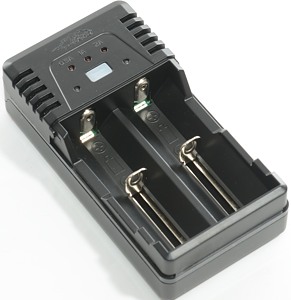
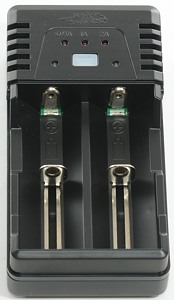
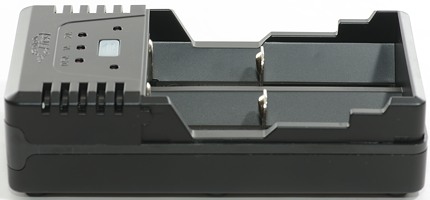
Efest is mostly know for LiIon batteries, especially IMR where they have many sizes, but they do also sell chargers, here is a test of the BIO V2 charger. The specifications look nice: 3 charge currents (0.5A, 1A and 2A), usb output, can handle up to 26650 batteries. Does it also work correctly:
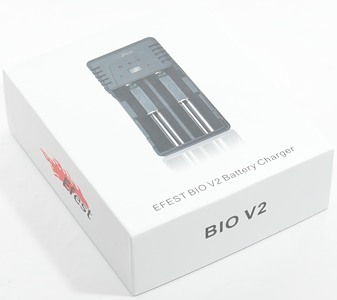
The charger arrive in a "small" white cardboard box.
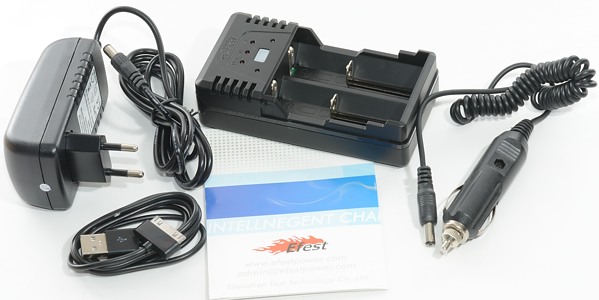
The box contained: Charger, mains power supply, car cable, iXXX (Apple) cable and manual.
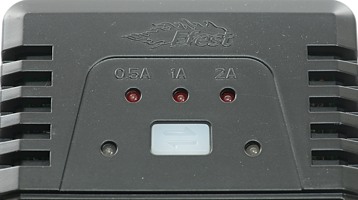
The charger has a very functional control panel with one button and 6 leds:
3 red leds for showing charger current (0.5A, 1A, 2A), the button is used to change between them.
2 red/green leds for showing if the batteries are charging (Red when charging, green otherwise).
1 blue led (behind the button) to show when usb out is activated, this is also done with a press on the button.
The red and red/green leds only works when the charger is powered, the usb output blue led only works when the charger is unpowered (i.e. using a battery).
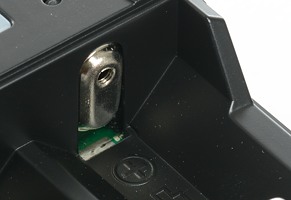
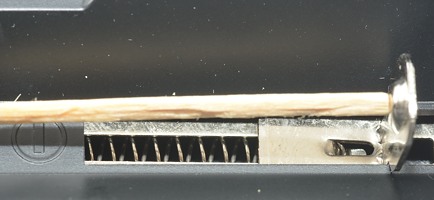
The battery + connection is slightly raised and worked with flat top batteries. The slider works fine.
The slider can work with batteries between 30.5 mm and 70 mm.
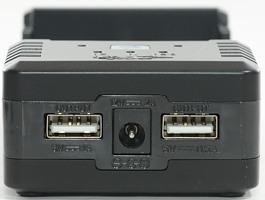
One the end the charger has DC input and two usb outputs.


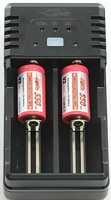
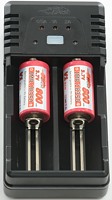
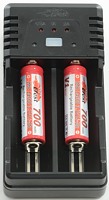
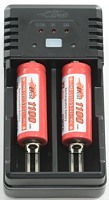
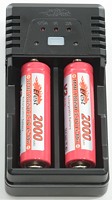
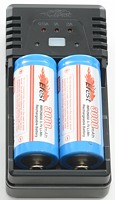
The charger can handle 70 mm long batteries including flat top cells.
The charge current is to high for 10440 batteries and I will not recommend charging them in the charger.
Measurements charger
- When charging at 2A it gets smelly and hot (52°C).
- When not connected to power it will discharges with at least 5mA.
- When power is connected the charger will charge with 80uA.
- At 0 volt on the battery the charge current is 70uA, dropping to about 0 uA at 0.7 volt (Green led is on).
- From 0.7 volt up to 2 volt the battery will be discharge with between 0 mA (at 0.7 volt) and 2 mA (at 2 volt) (Green led is on).
- At 2 volt the charger will start charging with about 250mA and the red led will turn on.
- At 2.85 volt the charger will switch to full charge current.
- Reinsertion of battery or power cycling will restart charging.
- When battery drops below 3.95 the charging will restart.
- The channels on the charger are independent, i.e. there are small differences between them.
.png)
First test is a Panasonic 18650 with 3100mAh capacity. The charger uses a CC/CV curve, but it charges to about 4.28 volt and the termination current is 370mA (50-100 is the best value).
This is not a very good CC/CV charge curve, even though the two problems is partially canceling each other out.
.png)
The 3400mAh cell works exactly the same way.
.png)
With the 2600mAh cell the termination is not really working and the charger is turning on/off at a fast rate. Looking at the final battery voltage, it can be seen that it is not fully charged.
.png)
The charger can handle my old IMR cell, but again it uses to high charger voltage.
%20%232.png)
The other channel works the same way.
.png)
At 0.5A charger current the problems are the same. The termination current has been reduced to 270mA, but that is also way to high.
.png)
.png)
I do not know what happened here, the charge voltage stays at 4.2 volt.
%20%232.png)
Second channel is again the same.
.png)
I am using two 26650 batteries for the 2A test, again the charger voltage and termination current is way too high. The battery temperature is fine, but that is a bit deceiving, because the charger started to smell and I measured 52°C on the charger.

M1:64.0°C, M2:52.7°C, HS1:73.5°C
Using a thermal imager gives a better picture of the temperature, the electronic inside the charger gets up to at least 73.5°C degrees and this heats the plastic and the usb connectors (They do fell hot when touched, because they are metal).
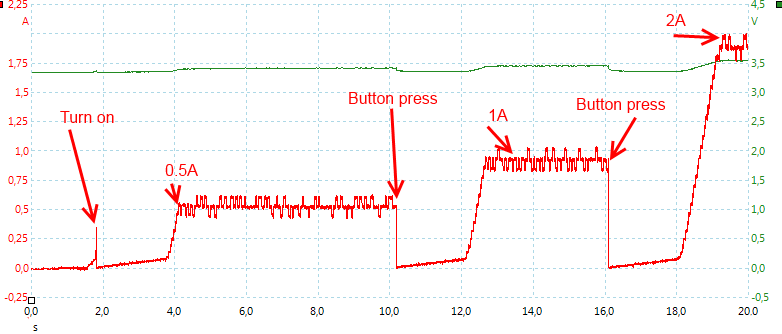
The charger has a fast startup and uses a slow ramp, when changing charge current. There is a lot of noise in the charger current, using filtering on my scope shows it as the square pulses on the curve.
Measurements USB output
- The charger can only use one battery for the usb output
- The button is used to turn on the usb output, but can only turn it off when unloaded.
- The blue led start flashing when the battery is down to about 3 volt.
- Does not turns off when overloaded, voltage just drops to 0 and will recover when load is removed.
- Both usb output is coded as Apple 1A.
- When the load is below 14mA the output will turn off in about 30 seconds.
- The blue led starts flashing at about 3.1 volt
- I have seen up to 30mA battery current, with the output turned off.
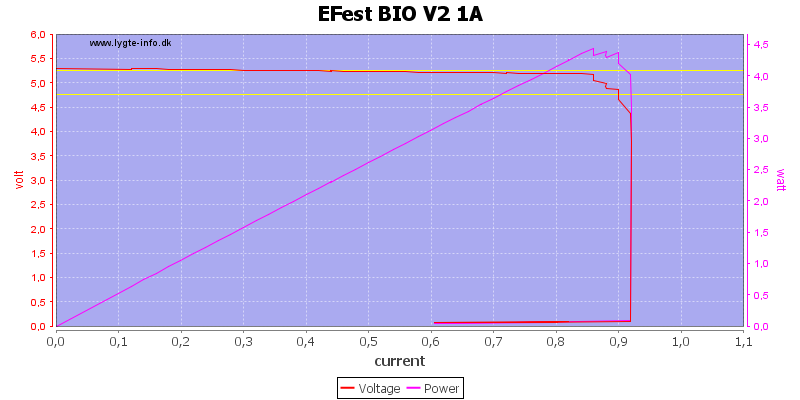
The charger has two usb output and I decided to do a test on each of them. The above curve shows the 1A output, it works fine to 0.8A (See below), but then starts to sag.
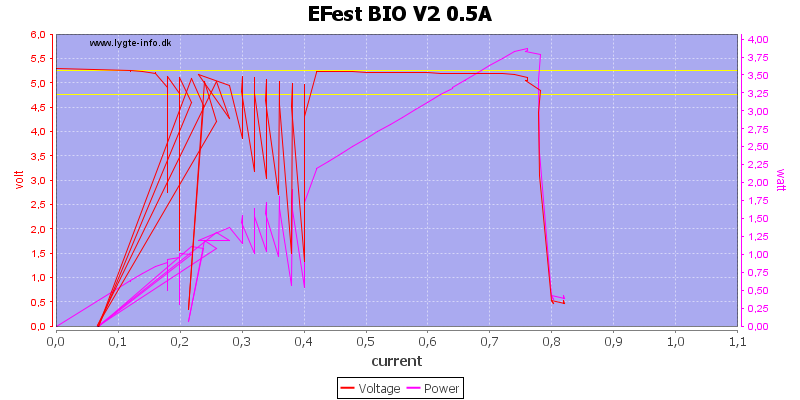
The 0.5 output does some very strange things between 0.2A and 0.4A.
.png)
I decided to a load test with a resistor (instead of the electronic load) in the strange range. Using a 15 ohms resistor means 330mA load at 5 volt, but as can be seen from the curve, the output did not reach 5 volt for the first two hours, it jumps up and down at a fast rate. I.e. this output is basically useless and might even harm some electronic.
.png)
The 1A output works very fine at 0.5A load.
.png)
At 0.8A load it does not work, there is a lot of noise and after an hour the voltage drops.
.png)
I did test with 7, 8 and 9 ohm and at 9 ohm it does nearly work, only the last 10 minutes does strange things.
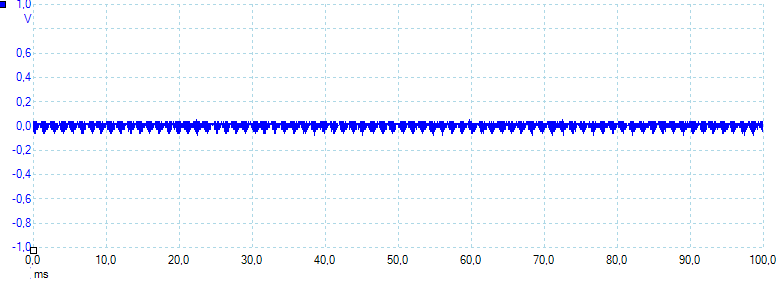
I only did a noise measurement at 0.5A load on the 1A output. It did give a good result with only 25mV noise.
Testing with 2500 volt and 5000 volt between mains and low volt side, did not show any safety problems.
Conclusion
The features of the charger is good, but the actual implementation is not very good.
The charge voltage is to high and the termination current is to high and only one of the usb outputs works and only at 0.5A, not the specified 1A.
Notes
The charger was supplied by msitc-shop for a review.
Here is an explanation on how I did the above charge curves: How do I test a charger
Read more about how I test USB power supplies and chargers

















.png)
.png)
.png)
.png)
%20%232.png)
.png)
.png)
.png)
%20%232.png)
.png)




.png)
.png)
.png)
.png)
